This pork in tomato and wine sauce is made with tender pork shoulder, simmered in a French-style blend of tomatoes, wine, and herbs, then finished with a buttery roux.
Recipe Intro
Origins
This type of pork ragout has roots in rural southern France, where home cooks relied on slow braising techniques to transform tougher cuts into deeply flavoured sauces. Traditionally, the base was made from broth prepared with pig’s feet, ribs, or other inexpensive offcuts, lending richness and gelatin to the final dish. Red wine and tomatoes became common additions in the Languedoc and Provence regions from the 19th century onwards.
This recipe
This version is adapted from a pork braise found in Henri‑Paul Pellaprat’s La Cuisine de tous les jours (1914), a collection focused on practical, everyday French cooking. The original recipe uses wine, aromatics, and flour-thickened broth to build the sauce around slow-cooked pork, without the addition of tomatoes. This version follows the same structure but adds a Provençal influence, using a tomato base, fresh herbs, and a homemade pork trotter broth in place of stock cubes. The meat is fully shredded into the sauce as it cooks, and the final texture is adjusted with a light roux.
Ingredients for French pork in tomato and wine sauce
- pork – Use boneless pork shoulder steaks for best flavour.
- butter – Use unsalted butter.
- bacon – Use unsmoked, finely chopped or diced.
- onion – Use large yellow onions, finely chopped.
- garlic – Crushed or finely chopped.
- herbs – Bay leaves, basil, rosemary, sage, parsley.
- broth: Homemade pork broth: 2–3 pork trotters, 1 large onion, 2 carrots, 1 celery stalk, 2-3 bay leaves, and a few peppercorns; yields 500 ml to 1 litre.
Alternative: Ready-made beef or chicken stock, or stock powder or cubes dissolved in water (approx. 1 litre). - wine – Use a dry red wine of your choice; something medium-bodied like Merlot, Grenache, or Côtes du Rhône works well. Avoid sweet or heavily oaked wines.
- tomatoes – Use good-quality tinned (canned) chopped tomatoes, with no added sugar or herbs.
- tomato concentrate – Use double-concentrated tomato paste from a tube or tin.
- sugar – Use plain white caster sugar to balance the acidity of the tomatoes.
- butter – choose high-quality, unsalted butter.
- flour – Plain white ( all-purpose) flour.
- olive oil
- cheese – Hard cheese for grating. Optional.
Love bold sauces? Check out Austrian Beef Stew
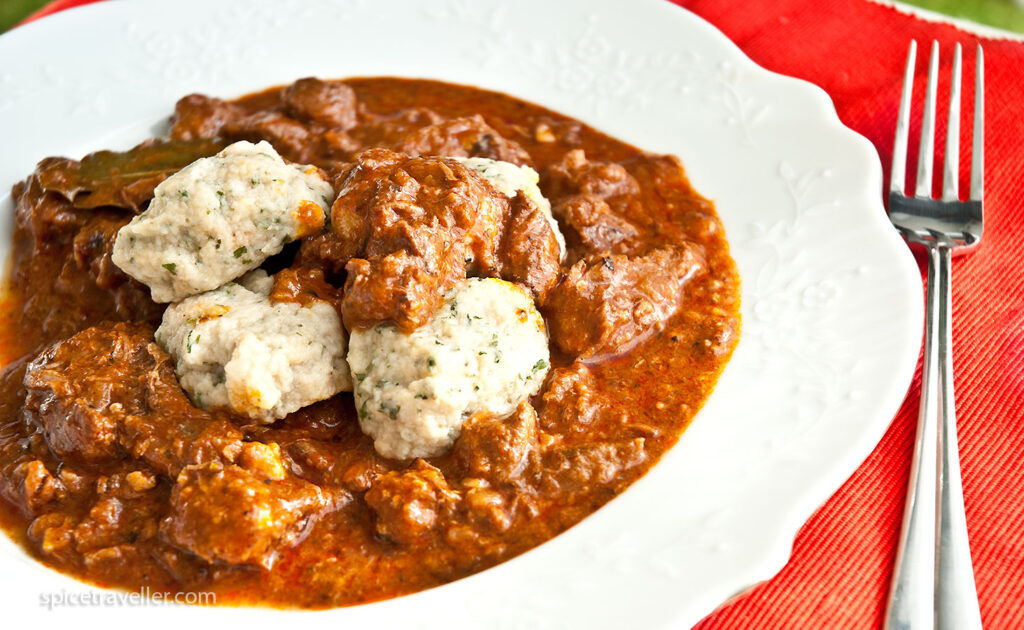
How to make French pork in tomato and wine sauce
A few words before you start
This isn’t a quick recipe, but it’s worth every step. The method is detailed because the flavours build in layers, and that slow-cooked pork shoulder with homemade broth truly makes a difference. Take your time and enjoy the process; it’s proper old-style cooking, and the result is unforgettable.
Preparing the Pork
Rinse the pork steaks under cold water to remove any residue, then dry them well with kitchen paper. If there’s moisture on the surface, the meat won’t brown properly. Lightly season both sides with salt and pepper, no need to overdo it, since the sauce will carry most of the flavour.
Heat a few tablespoons of olive oil and 2 tsps of butter in a large, heavy-based pot over medium-high heat. Once hot, add the pork and sear it for 3 minutes on each side. You’re not trying to cook the meat through at this point, just build up a nice layer of flavour on the bottom of the pot. Once the steaks are browned, lift them out and set them aside on a plate. Cover them loosely with foil to keep warm.
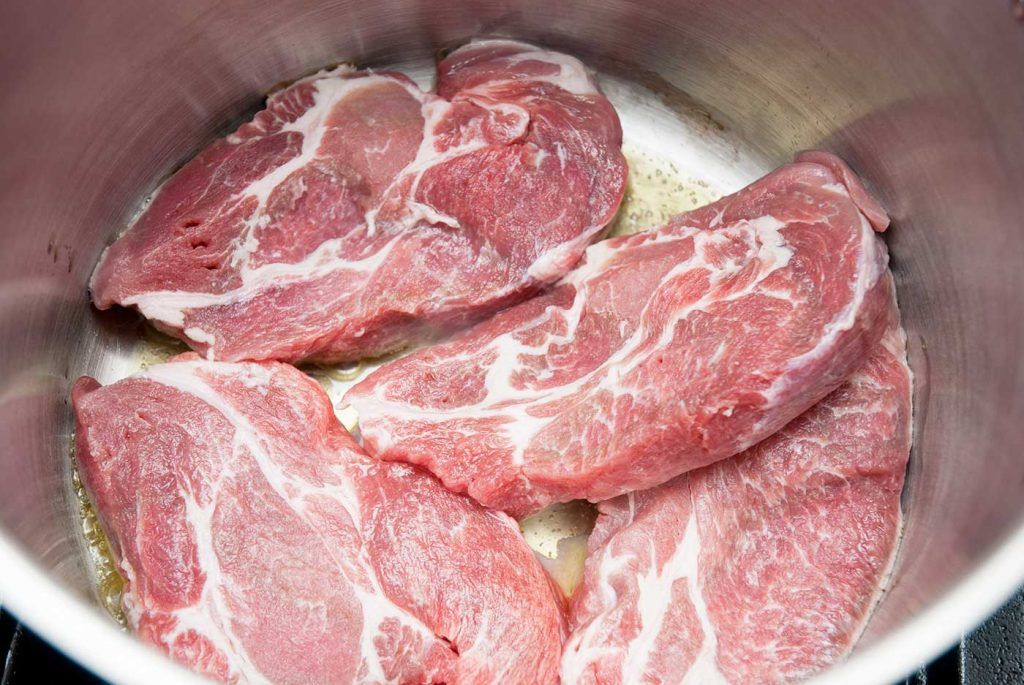

Building the Flavour Base
In the same pot, without wiping it out, add finely chopped bacon. Fry it for two minutes, then add sliced onions. Cook for another 5 minutes until they soften slightly, scraping the bottom occasionally. Add the chopped garlic and stir for a minute, just until it becomes fragrant.
About the broth: Traditionally, this dish would be made with homemade pork broth, ideally one prepared from simmered pork trotters or ribs and slow-cooked for 8-10 hours.
For this version, trotters were simmered earlier with onion, carrot, celery, bay leaves, and peppercorns for 2 hours to create a rich, gelatinous broth. About 300 ml of that strained broth is used here to deglaze the pan. As soon as you pour it in, use a wooden spoon to scrape up all the browned bits; they’ll dissolve into the liquid and add depth to the final sauce.
If you’re not making broth from scratch, you can substitute with beef or chicken stock instead. Even vegetable broth will work, though it won’t bring the same depth. The key is to choose something with body. The pork trotter broth makes a noticeable difference in texture and flavour, but the dish is still worth making with whatever you have on hand.
Slow Cooking the Pork
Return the browned pork steaks to the pot. Add the bay leaves, rosemary, sage, and basil (leave the parsley for later). Pour in enough to just cover the meat. Bring the broth to a simmer, then cover with a lid and reduce the heat. Let it cook gently for about two hours. It should stay at a low simmer, not boiling.
Check on it every so often to make sure the liquid hasn’t dropped too low. If it looks dry or starts catching on the bottom, add more broth. The pork should be slowly breaking down as it cooks, and by the end, it should be tender enough to easily shred with a wooden spoon.
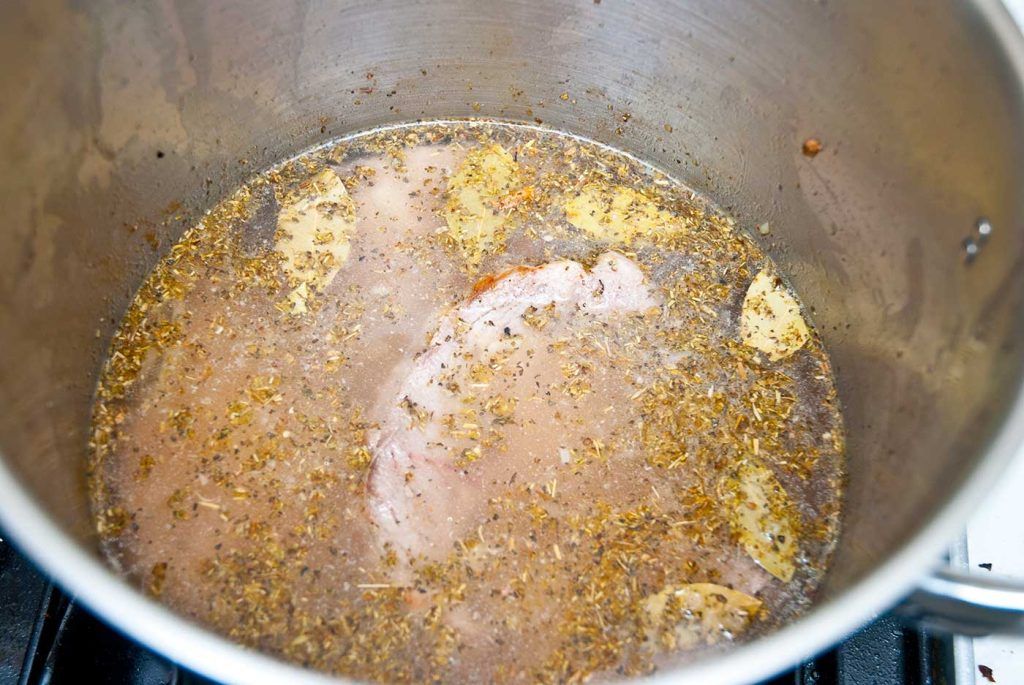
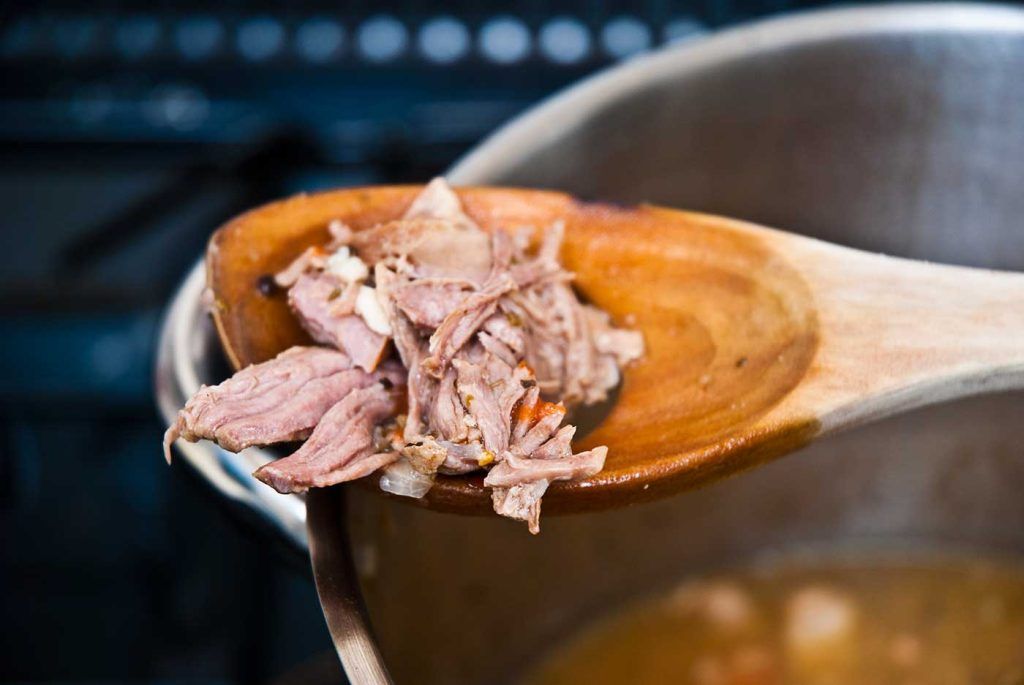
Finishing the Sauce
When the pork is soft and falling apart, use a spoon or spatula to break it up directly in the pot. Stir in the tinned chopped tomatoes, tomato purée, and sugar to balance the acidity. Pour in the wine. Season with more salt and black pepper to taste, then let the sauce bubble gently for another 20 minutes uncovered. This helps it thicken and brings the flavours together.
Make the roux
Meanwhile, melt the butter in a separate pan and stir in the flour to make a roux. Cook it over low heat, stirring constantly, until it turns pale golden and starts to smell nutty — this usually takes 1-2 minutes.

Slowly pour the roux into the sauce, while stirring constantly to avoid lumps. If the mixture becomes too thick, loosen it with a little extra broth.
Add the chopped parsley and let the sauce cook for just another minute. The texture should be rich and glossy, with the meat fully shredded into the sauce.
Resting the pork and tomato sauce
Take the pot off the heat and let it rest for at least an hour before serving. Resting is essential; it allows the flavours to settle and the sauce to thicken naturally. When you’re ready to serve, if needed, reheat gently over low heat for a minute or two, without letting it boil.
This sauce gets even better the next day, richer, deeper, and worth the wait.
Serving Suggestion
Traditionally, this kind of slow-cooked French pork sauce would be served with boiled or steamed potatoes, or simply with bread, typically a rustic country loaf or pain de campagne to soak up the sauce.
That said, it’s just as delicious poured over pasta. I’ve made this many times, often serving it over penne or sometimes mixing the sauce with the pasta before serving, which I find makes it even tastier.
A generous handful of grated cheese on top really brings it together, not strictly traditional, but it melts right into the sauce and adds that final, savoury finish over pasta. 🙂
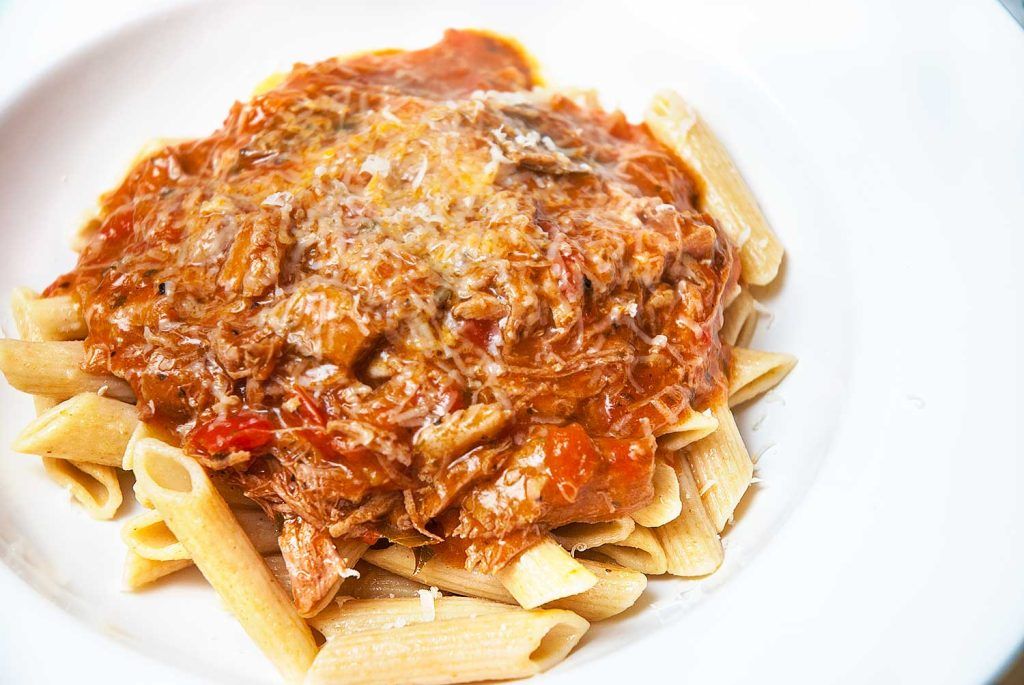
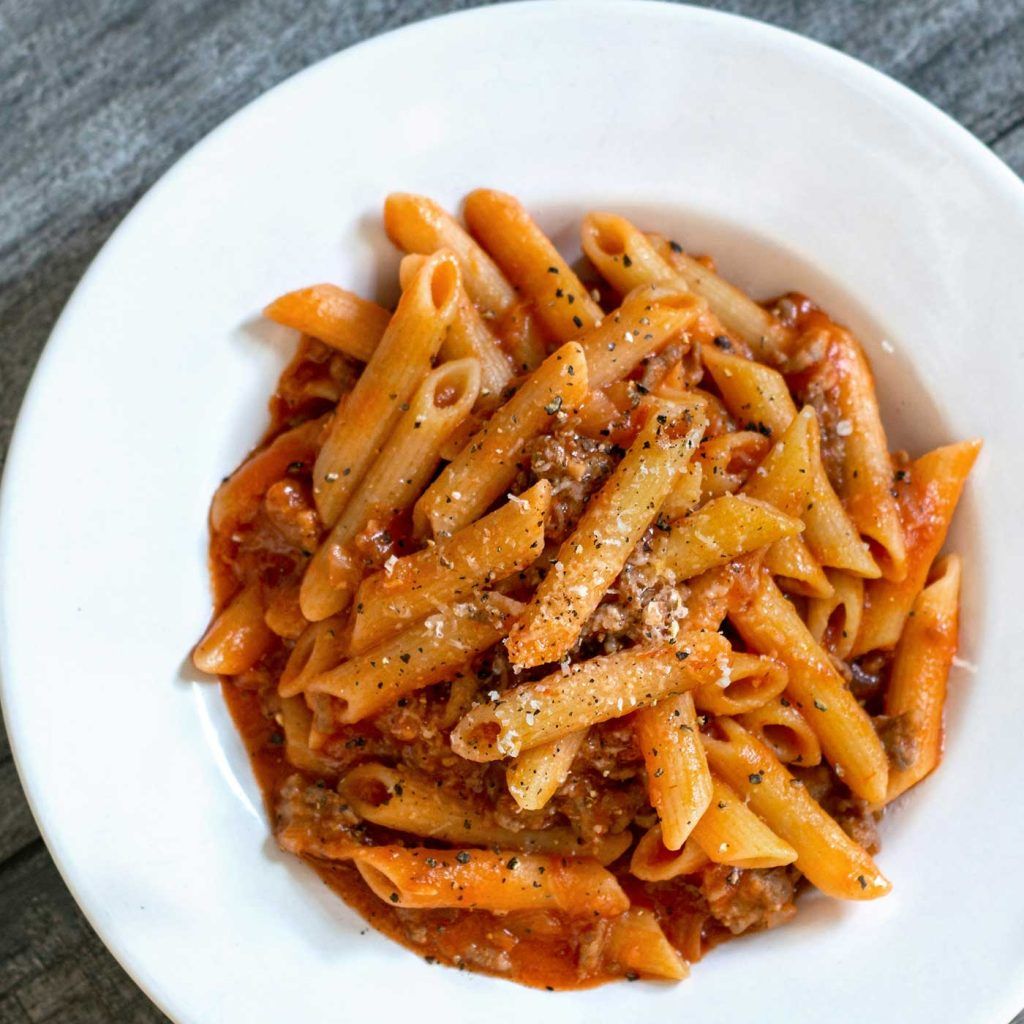
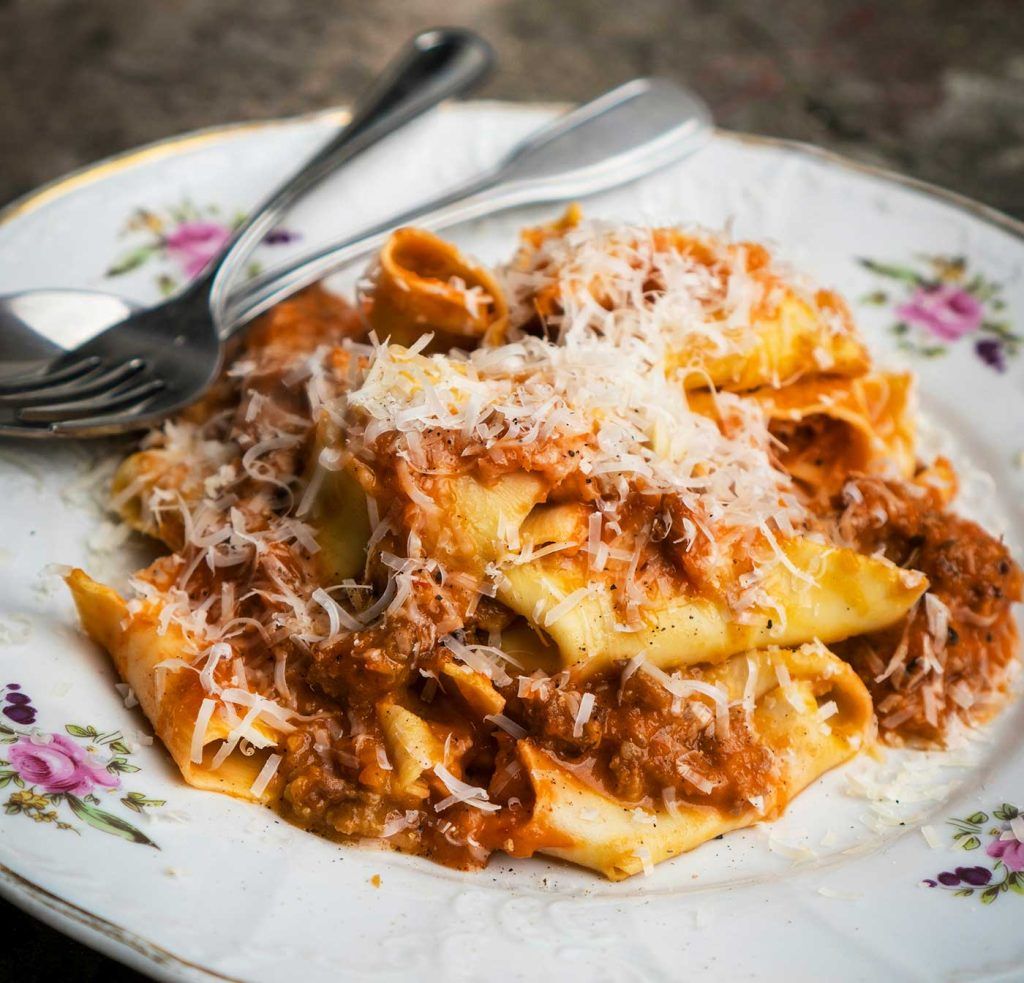
🍷 🇫🇷 Love French food? Check out more dishes here.
Recipe Card
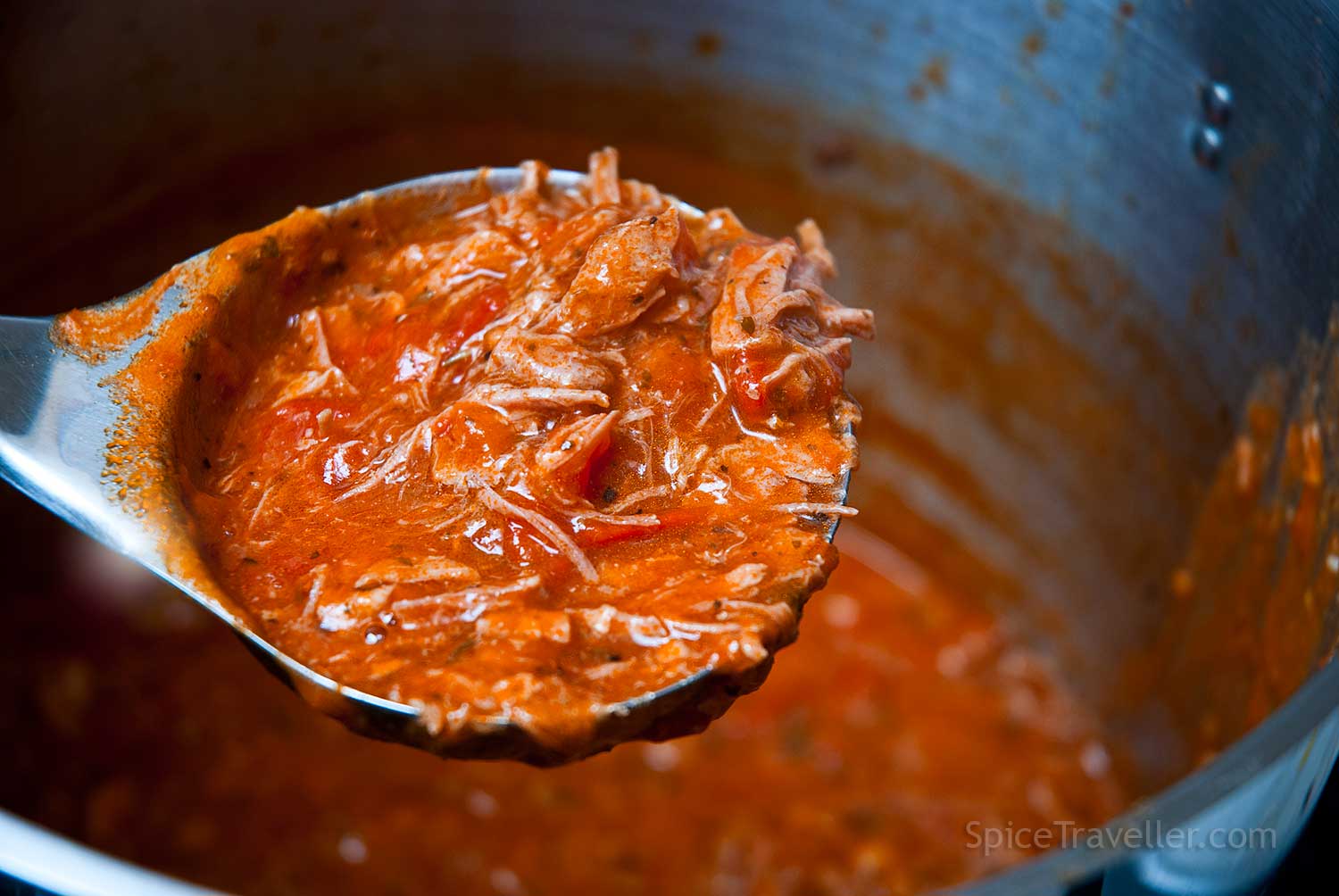
Pork in Tomato and Red Wine Sauce
Ingredients
- 4 pork shoulder steaks - approx. 700–800 g total
- 100 ml olive oil
- 2 tsp unsalted butter
- salt, black pepper - for meat seasoning
FOR THE SAUCE
- 1/2 CUP chopped unsmoked bacon
- 2 large onions - finely sliced
- 5-6 garlic cloves - chopped or crushed
- 2 x 400g chopped tomato can
- 200 ml red wine
- 2 tbsp tomato concentrate
- 1 tbsp plain white caster sugar
- 1 litre homemade pork broth (see recipe post) - or use chicken, beef, or vegetable stock
- 2 tsp freshly ground black pepper
- 1 tsp salt
- 4-5 bay leaves
- 1 tbsp dried rosemary
- 1 tbsp dried basil
- 1 tsp dried sage
- 2 tbsp fresh parsley
SIMPLE ROUX
- 50 g unsalted butter
- 2 tbsp plain (all-purpose) flour
TO SERVE
- grated cheese of your choice - optional
Instructions
- Rinse the pork steaks, pat dry, and season lightly with salt and pepper.
- Heat olive oil and 2 tsp butter in a large pot over medium-high heat. Sear pork for about 3 minutes per side until browned. Remove and cover with foil.
- In the same pot, fry chopped bacon for 1–2 minutes, then add sliced onions. Cook until softened, then add garlic and cook for 1 minute more.
- Deglaze the pan with about 300 ml of homemade pork broth (or ready-made stock). Scrape up the browned bits.
- Return pork to the pot. Add bay leaves, rosemary, sage, and basil. Pour in enough broth to just cover the meat.
- Bring to a simmer, cover, and cook gently for about 2 hours. Add more broth as needed to prevent drying out.
- Once pork is very tender, break it apart in the pot using a wooden spoon or fork.
- Stir in chopped tomatoes, tomato concentrate, sugar, and red wine. Season to taste. Simmer uncovered for 20-30 minutes.
- In a separate pan, melt butter and stir in flour to make a roux. Cook for 1–2 minutes, then slowly stir into the sauce.
- After stirring in the roux, let it simmer for 5 minutes. If the sauce is too thick, loosen it with a splash of broth. If it’s too thin, let it simmer uncovered a bit longer until it reduces to your preferred consistency.At the end, add chopped parsley and cook for 1 more minute.
- Let the sauce rest off the heat for at least 1 hour before serving. Reheat gently without boiling if needed.
